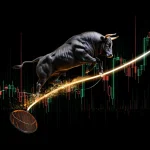
Will Confidence or Panic Define Your Next Trade?
Jan 15, 2025
Is the surge and slide of share prices shaped by reasoned study, or do group emotions carry greater sway during times of stress and exuberance? Many traders claim to be guided purely by data, yet the reality often exposes a tug-of-war between facts and feelings. One day, an optimistic headline might spark a buying frenzy, only for a whiff of bad news to trigger mass selling the next. Stock market fluctuations today can feel like a rollercoaster, leaving newcomers and experienced professionals alike questioning how to strike the right balance. Regardless of how sophisticated one believes the market to be, human impulses remain at its heart.
Picture a party where everyone is talking about their latest share-buying triumph. Last week, a friend swore by a technology firm, and within days, it soared. Others joined in, convinced that the upward climb would never cease. This is a familiar story: a wave of enthusiasm propels prices higher, and excitement spreads. But markets tend to shift once unbridled cheer reaches a certain peak. Whether it was the dot-com craze of the late 1990s or property speculation leading up to 2008, bursts of confidence often blind many to impending risks, then, when conditions change, that same crowd can race for the exits, creating a stampede that drives prices far below their fair worth.
Such episodes highlight the age-old tension between rational judgment and the powerful lure of emotional chatter. Experts in behavioural finance underscore how initial forecasts can be undone by group behaviour—when a single nudge can morph into a craze. Meanwhile, traders who combine psychological awareness with technical markers may stand a better chance of navigating the waves. But what should one do in moments of panic or euphoria? The answer is not always straightforward. Market timing requires a careful watch on human sentiment and a willingness to go against the flow at key intervals. In this essay, we will examine how well-timed buying in a fearful climate can often outshine the impulse to sell and why locking in gains during frenzied peaks can protect an investor from a sudden downturn.
The Influence of Human Emotions on Market Waves
Why do market prices sometimes soar far above logical valuations, only to plummet just as quickly? The answer lies largely with human emotions that swing between longing for quick profits and fear of catastrophic losses. Academics in psychology have long noted how powerful emotions can override what might seem like common sense. In times of widespread optimism, even warnings from seasoned analysts can seem irrelevant, drowned out by the thrill of immediate gains.
One famed illustration is the dot-com phenomenon. In the late 1990s, new internet companies with little more than a catchy name and a big promise saw their share prices multiply. Fuelled by glowing headlines and dreams of digital triumph, countless investors poured in, hoping not to miss out on the latest superstar stock. The party continued for a while, then halted dramatically. The dot-com bubble revealed how easily euphoria masks red flags. When the bubble burst, shares of those same companies collapsed, marking a painful chapter for many who failed to recognise the signs of dangerous overvaluation.
A parallel can be drawn with the 2008 housing crisis. Home values seemed destined to rise forever, banks kept lending freely, and investors snapped up mortgage-backed securities with little regard for the growing threat of defaults. The eventual collapse was devastating. Yet, amid the rubble, certain contrarians stood poised to swoop in at bargain levels, paving the way for profits once the healing process began. By understanding how crowd emotion had inflated the market, those brave enough to buy when anxiety was rife were prepared for the rebound. On the other hand, the majority who sold into the plunge often locked in their losses.
The thrill of a rising market and the dread of a falling one represent two sides of the same coin. Headlines, social media chatter, and the emotional heartbeat of the crowd can fuel both. Traders who base their decisions solely on immediate trends may feel safe in the comfort of the herd—yet history teaches that the crowd can be wrong in spectacular ways. A calm analysis of how emotions shape these waves can mean the difference between capturing opportunities and, sadly, joining a frenzy too late.
Contrarian Thinking: Antidote to Blind Herd Behaviour
There is a well-known saying in finance: “The time to buy is when there is blood in the streets.” Although the words may sound grim, they point to a key idea: a moment of chaos can present some of the greatest chances for those who keep their heads. Selling in a panic often locks in a loss, while the investor who stands ready to purchase undervalued assets may reap significant rewards down the line. This contrarian strategy calls for cool nerves and a willingness to step away from the popular view.
Consider how many run from the market when prices are crashing, convinced that a further drop is all but guaranteed. Yet, the keen observer remembers that previous crashes often paved the way for remarkable recoveries. The 2008 financial meltdown saw global share prices plunge, leading some to conclude that the economic system was beyond repair. Yet within a few years, many of those battered shares had bounced back, handsomely rewarding those who had been bold enough to buy when conditions looked bleakest.
Similarly, as the dot-com bubble inflated, some sceptics argued that firms with thin revenue streams could not justify those towering valuations. Anyone who took profits before the peak and rotated capital into safer assets possibly missed a bit of the final lift. However, they also avoided the steep losses that followed. Bucking the herd—either by selling in moments of wild cheer or buying in moments of terror—can be a powerful move.
The stumbling block is that no one has a crystal ball, and going against group sentiment can be profoundly uncomfortable. Neighbours might brag about astonishing gains just before the bubble bursts, and it is never easy to stand aside when so many appear to have found a shortcut to fortune. Yet contrarian actions remain a tool for those who accept that markets oscillate more wildly than corporate earnings or economic data alone might justify. By acknowledging this reality, one can tailor decisions to benefit from swings rather than get swept away by them.
How Timing and Technical Analysis Can Help
While no single method provides an all-seeing guide, technical analysis can offer clues about momentum shifts. Signals such as simple moving averages, relative strength indices, or chart formations can hint at whether markets have moved too far in one direction. Though critics caution that chart signals are not foolproof, they have often added structure to decisions where emotion can run high.
For instance, if a market is spiralling downward amid widespread panic, a trader might seek confirmations of a potential rebound by watching for divergences in price and volume. Buyers stepping in at a certain level may mark a floor, signalling that sellers might be running out of energy. On the other hand, if a share price has climbed for many months on sensational news, one might watch for signs of weakness or a break below a key support line to indicate that the upward rush is losing steam.
Technical measures are no substitute for strong judgment. However, they can act like signposts, warning of possible reversals before the mainstream mood catches on. When part of a broader plan that also acknowledges economic indicators and psychological trends, these tools may help an investor spot the beginnings of a market turn. One can reduce the chance of acting solely on hunches that lack any factual foundation by verifying suspicion with data- from chart shapes to volume patterns.
Imagine, for example, that a classic head-and-shoulders formation emerges in a market achieving record highs. This clue might prompt a cautious investor to lighten positions, even as headlines still glow with optimism. Conversely, if a moving average cross suggests buyers are regaining control in the wake of a painful sell-off, the contrarian buyer might size up a potential entry. In either case, technical analysis can help to calm nerves in uncertain waters, aligning decisions with historical patterns of buyer-seller behaviour.
Fear and Euphoria: The Yin and Yang of Market Cycles
Step back for a moment and observe how fear and euphoria alternate. Whenever markets surge, investors speak of fresh breakthroughs and exciting prospects. Fuelled by rosy forecasts and success stories, more funds pour in, pushing prices even higher. However, the tide often turns when hubris leads to oversized bets. At this stage, a minor shock—a disappointing earnings report, a wider economic concern, or even a geopolitical event—can burst the bubble of cheer. A once unstoppable climb transforms into a scramble to offload positions. Fear spreads quickly as investors who blissfully chased quick profits retreat, and a wave of selling drowns valuations.
The bizarre truth is that these violent flips from optimism to despair happen time and again. From the wild run-up of tech shares in the late 1990s to property mania in 2008, the pattern is consistent. On the upbeat side, people forget that corrections are a natural cleansing mechanism. On the fearful side, they lose sight of the fact that markets eventually recover. A balance between these extremes is hard to achieve when the stakes are high. Media outlets can magnify swings by emphasising dramatic headlines, causing waves of emotion that trigger either mass buying or hurried selling.
Experts in behavioural finance highlight a range of triggers for these shifts, from the desire to avoid regret to the lure of making a fortune. While we might assume that modern-day investment platforms have decreased irrational choices, the opposite might be true. Social media speeds up group-driven decisions, turning a small rumour into the reason for massive moves in a matter of hours. Those who remain level-headed, armed with the knowledge that fear and euphoria are two sides of the market coin, tend to fare better in the long haul. Through consistent observation and a plan that takes into account both logic and emotional undercurrents, one can avoid extremes and opt for steadier gains.
Crafting Your Approach to Market Fluctuations
Every investor sets out intending to make decisions that will grow wealth and avert unnecessary losses. Yet the real challenge lies in staying disciplined when the crowd is running in the opposite direction. Stock market fluctuations today continue to mimic patterns from past decades because human nature remains the same. Fear compels some to dump shares at the worst possible moment, while euphoria blinds many to looming hazards. The path to success is rarely about finding a secret formula. Instead, it is about reading signals, recognising emotional swings, and acting with consistency, even under pressure.
Experts have often stressed the value of having a clear plan. For instance, one might determine in advance how much profit is sufficient before closing a winning position, avoiding the temptation to cling on in hopes of infinite upside. The same can apply to losses: setting a strategy for when to accept a small decline and move on rather than waiting for a devastating plunge. The discipline to stick to predefined rules can protect a portfolio from the sabotage of momentary feelings.
At times, it may be wise to question whether your decision aligns with what “everyone else” is doing. If you find yourself following friends into the hottest trend simply because it keeps climbing, pause to investigate whether the charge might be built on hype. On the flip side, gatherings of doom-laden predictions might signal an overreaction, leading share prices to plummet below their long-term worth. Awareness of how the majority behaves helps in anticipating potential turning points. While these cues are not foolproof, they encourage a more serious study of valuations, sentiment, and, if helpful, technical charts. In merging these elements, an investor charts a course that reduces the risk of severe mistakes.
One can draw lessons from past collapses to see that fortunes are sometimes made in times of crisis, not just in times of euphoria. Zeroing in on shares that remain fundamentally sound but which have been pressed down by the crowd’s stampede can offer extraordinary openings. Meanwhile, taking some profit during a thrilling upswing can preserve hard-earned gains when the broader mood shifts. The challenge is to maintain the courage and foresight to do so. After all, it is easy to be caught up in the feeling that whatever is happening right now will carry on far longer than it actually does.












